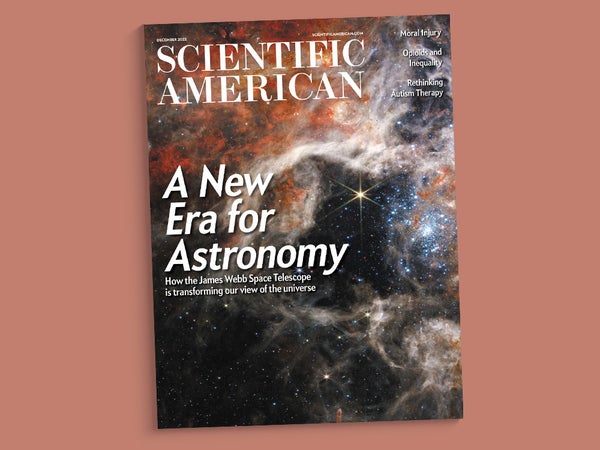Aren’t the first images from the James Webb Space Telescope absolutely stunning? We were thrilled and hopeful when JWST finally launched last Christmas Day after decades of delays, and the first images and data from the telescope are even more fascinating than astronomers anticipated. In our special report, journalist Jonathan O’Callaghan shows how these images of the most distant galaxies ever seen are already changing cosmologists’ understanding of the universe’s early history. Astrophysicist Fabio Pacucci shares the excitement of discovering galaxies in “empty” space. For the best explanation you’ll see of how JWST works, turn to the graphics from our space and physics editor Clara Moskowitz and graphics editor Jen Christiansen. The package ends with a gorgeous gallery of JWST images, with text from Clara, who produced the collection. We hope this is just the beginning of JWST’s ability to help us explore the universe.
Moral injury is newly being recognized as a serious and widespread type of psychological trauma. It starts when people are forced to do something that violates their moral code, such as when a hospital has more patients than it can treat and doctors and nurses have to triage health care. Psychiatrists are finding evidence of moral injury in teachers, lawyers, people who served in the military, and more. They suspect many cases are unrecognized because people aren’t familiar with the concept. As science writer Elizabeth Svoboda explains, understanding this type of trauma can be the first step to healing.
Opioid addiction in the U.S. is a growing problem, and the death rate from drug overdoses continues its horrifying rise. Addiction is also a fixable problem, but people with addiction disorders—in particular Black people—aren’t getting the evidence-based treatments that can save their health and lives. Melba Newsome, a health, science and environmental writer, and photographer Gioncarlo Valentine depict doctors, scientists and advocates working to improve health care and social support for people with opioid use disorder.
On supporting science journalism
If you're enjoying this article, consider supporting our award-winning journalism by subscribing. By purchasing a subscription you are helping to ensure the future of impactful stories about the discoveries and ideas shaping our world today.
With this issue, we’re celebrating copy director Christi Keller’s 40th anniversary with Scientific American. Christi runs the department that copyedits and fact-checks everything we publish, keeps our schedules and deadlines, handles corrections, manages our relationships with our printers, and makes sure every page is of the highest quality. She helped us transition from a purely print magazine to a print-plus-digital publication, and she and her diligent team helped us pivot smoothly from in-office to remote work during the pandemic. When I started my job as editor in chief, I asked my predecessor, Mariette DiChristina, whether there’s someone on staff who is the social core, who knows how everyone else is doing, and she immediately said, “It’s Christi.”
As part of our virtual celebration of Christi’s tenure, creative director Mike Mrak showed a mocked-up cover of Scientific American with Christi’s picture and witty headlines, many of which were misspelled or grammatically incorrect. Christi would like everyone to know that she is grateful for their faith in her to carry on at her “home away from home.”
When you subscribe to the magazine in print or online, give a gift subscription, or read or share our work, you help support a wise, kind, enthusiastic and incredibly dedicated staff. Thank you for being part of our Scientific American family.
